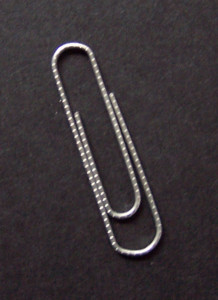Many attempts have been made over the years to improve upon the design of the paper clip. So far it has proven very difficult to design something that works better and can be made more economically than the ubiquitous twist of wire we know as the standard paper clip.
It may come as a surprise to many to find out that most paper clips sold in the United States are still also made in the United States. Import tariffs, which have been in place on paper clips since 1994, have helped to keep a robust domestic manufacturing business alive and well bucking the trend towards off-shoring so prominent since the late 1990s.
The number of paper clips sold in the United States annually is high and makes one wonder, what do we do with all those paper clips, particularly in the “paperless society”? According to the source and a quick survey of our offices, here’s a list of uses, other than holding papers together, to which we put paper clips: hanging Christmas ornaments; restarting electronic devices that have tiny little restart buttons; cleaning our fingernails/ears (with apologies); linking them into a chain while chatting on the phone, and temporarily holding up a ripped hem.
Today’s market size is an industry estimate of the number of paper clips sold annually in the United States.
Geographic reference: United States
Year: 2010
Market size: 11 billion clips
Source: James R. Hagerty, “Mousetraps, Maybe, but Can You Build a Better Paper Clip?” The Wall Street Journal, online edition of August 29, 2011, available here.
Posted on September 7, 2011


We ought to find out how the paperclip people managed to get themselves tariff protection. Nice going!
It is an interesting question: just how do some products and/or industries manage to get protection from imports, even in a period when increasingly liberal trade agreements are the norm?
A few years ago I’d have to pay someone for this informtaion.
Well now, that is an interesting comment… even if it was automatically generated. It provides a wonderful start for a discussion about the true value of statistical data, how we can support sources of reliable data collection and what might happen if we don’t… as we are failing to do by under funding the Census Bureau but… sadly, no time for that discussion just now.